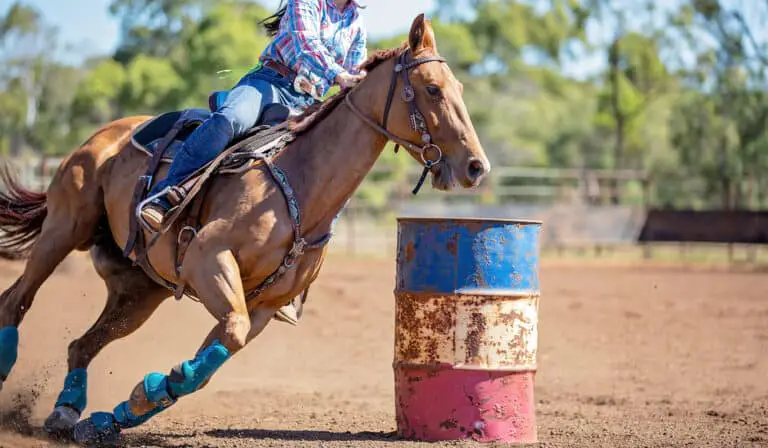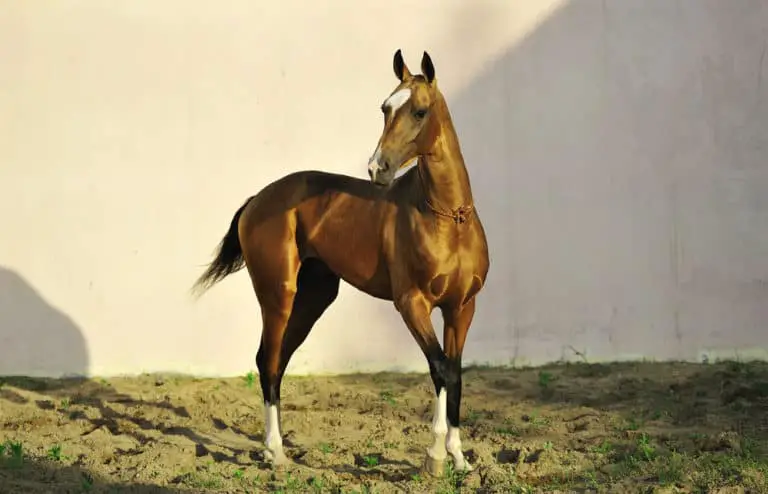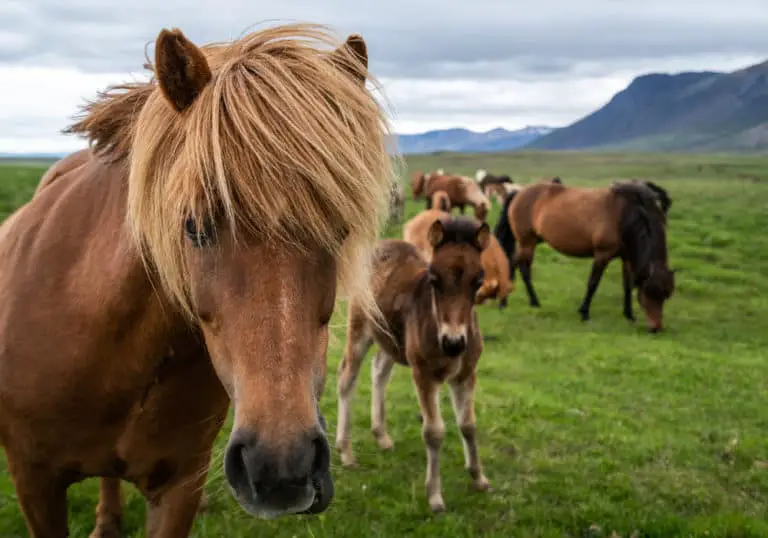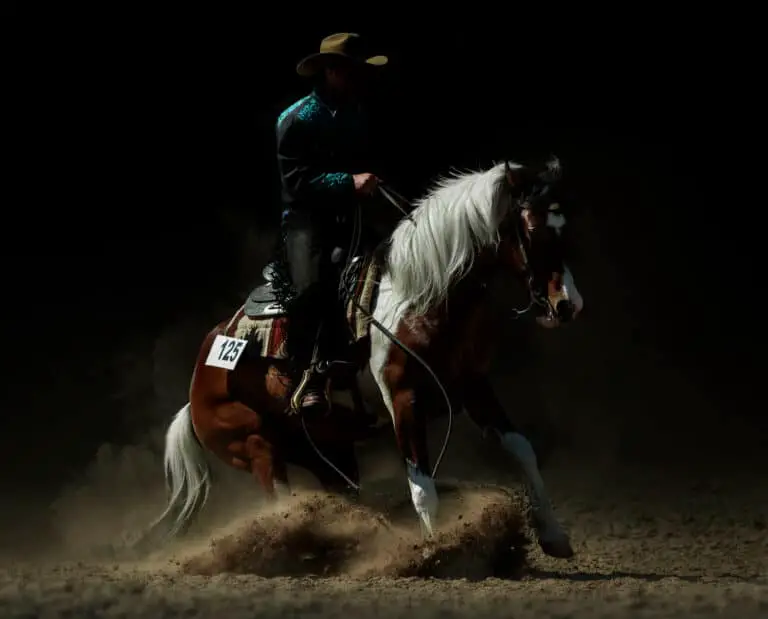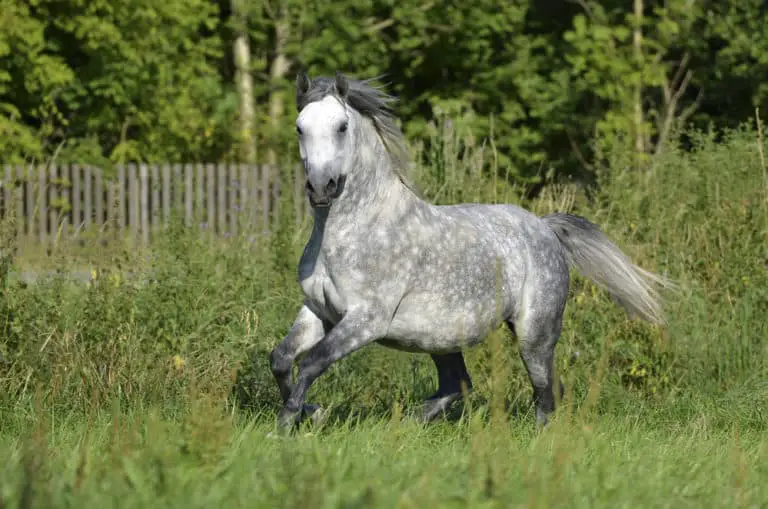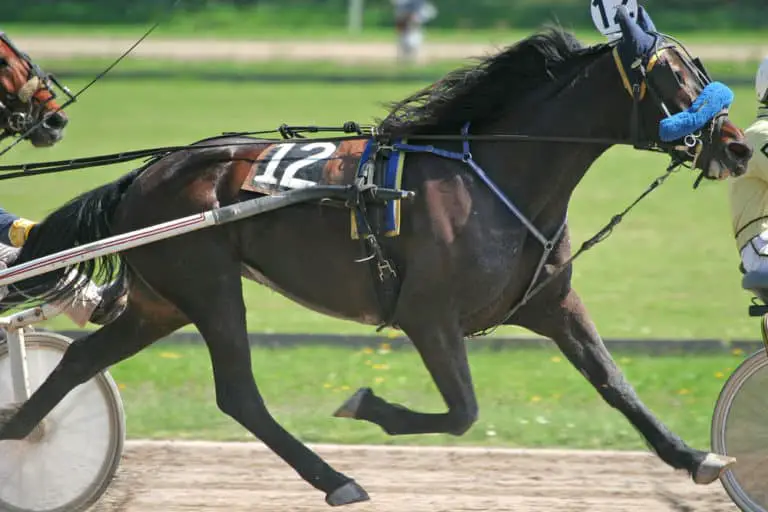Ardennes Horse: Care, Cost & History (2025)
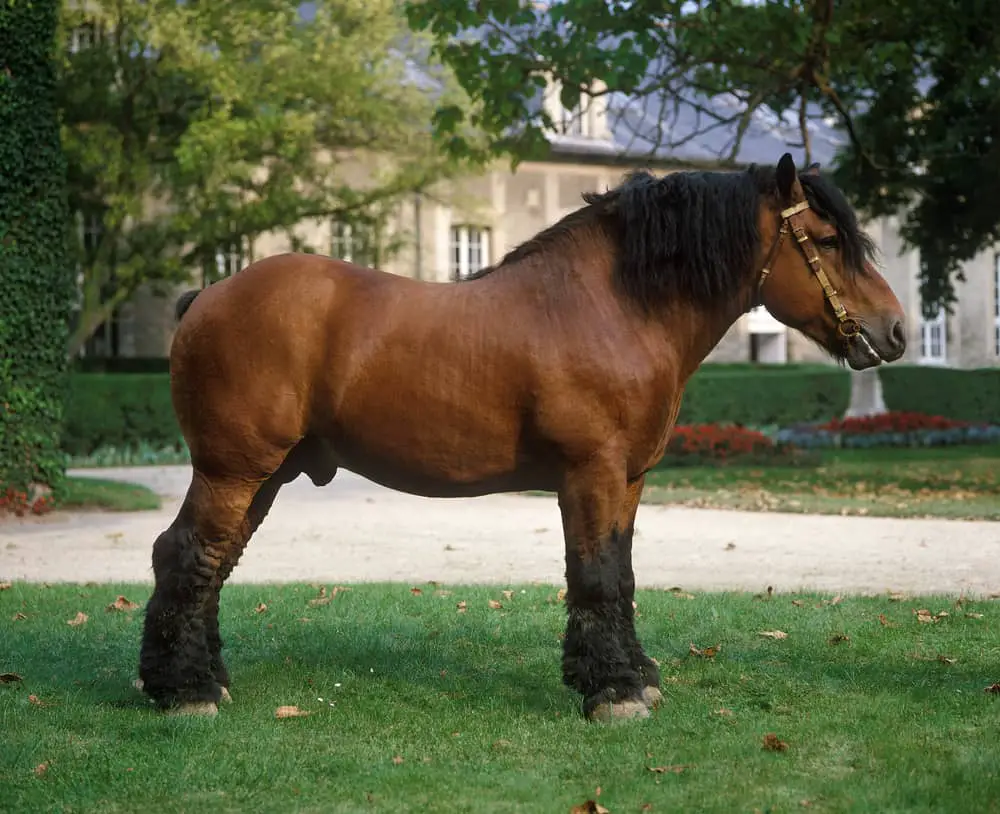
Ancient Romans used the Ardennes horse as war mounts; Caesar recommended them be used in the cavalry because he thought they were tireless. Napoleon later used them in his military campaigns as well. They are one of the oldest draft horse breeds with a long history of draft and agricultural use that continues today.
Breed: Ardennes horse
Adult Weight: 1,500-2,200 pounds
Adult Height: 15.2-16 hands (62-64 inches)
Origin: Ardennes area of Belgium, Luxembourg, and France
Use: Draft and farm work, driving events
Colors: Bay, roan, chestnut, gray, palomino
Features: Heavy bones, thick legs, large size
Lifespan: 25-30 years
Character: People-oriented and gentle
Gait: Long stride, free moving
Best for: All levels of riders
- Characteristics
- Ardennes Horse Care
- Ardennes Horse History
- Modern Ardennes
- Cost and Ownership
- Buying an Ardennes
- Similar Breeds
Ardennes Horse Characteristics
Ardennes horse characteristics are unique among other draft horse breeds and have remained relatively unchanged despite the infusion of other bloodlines. The Ardennes horse head has a noble look and gentle eyes. They are broad and muscular, with short backs and powerful hindquarters. The mane and tail are thick, as is their coat.
Size
Ardennes’ size doesn’t always seem proportionate, as their weight outpaces their height. The Ardennes horse height is averaged at 15.2 to 16 hands or 62 to 64 inches. (1) Stallions, or male horses, are slightly larger than mares or female horses. Height-wise, they are one of the smaller draft breeds but still powerful.
Although the breed standard states there is an ideal range for male and female height, they will allow Ardennes horses that are slightly taller or shorter. The Belgium breed registry is stricter about height than the one in France. Non-adult horses are at 73% of their adult height when they are three months old. (2)
Weight
The Ardennes horse weight is heavy relative to their height, and they average between 1,500 and 2,200 pounds. Combined with their height, this gives them a short, stocky, compact, and large appearance. It also makes them very powerful horses.
The Ardennais horse breed was short even in the Roman era, although not quite as heavy. Their bone structure and weight increased in modern times.
They developed large, dense bones in the 1800s, capable of supporting their heavy weight that increased the amount of power they had to pull wagons and complete agricultural work. Their thick leg bones are a defining characteristic.
Colors
Ardennes horse colors are bay, chestnut, roan, palomino, and gray. Bay and roan are the two most common breed colors. Black is not allowed in the breed registries and is a rare Ardennes horse color, along with the less common colors.
Horses can have white markings, although they are minimal and usually just a small star on the head. The white hairs in the coat pattern of the roan horses are more common than white markings.
The beautiful Ardennes horse can have varying shades of roan and bay and the coat color shades vary with the season as their thick winter coat grows in and then sheds out in the spring.
Temperament
The Ardennes horse temperament is people-oriented and gentle. They learn quickly, are docile, and well-mannered, similar to other draft breeds. The gentle nature of Ardennes horse behavior makes them popular with everyone, from beginners to experienced horse people.
They are also an intelligent breed, and this is part of what made them popular, first as war horses and later in agricultural work and pulling trams and wagons. Their intelligence, combined with their gentle personality, makes them kind and forgiving of any mistakes.
The United States Equestrian Federation doesn’t have breed-specific rules for the Ardennes horse. Therefore, they use the general rules, and children cannot exhibit stallions. (3)
Ardennes Horse Care
The Ardennes horse breed is considered an easy keeper and doesn’t require a lot of feed, despite their size. It’s easy going personality makes caring for it simpler too. Shelter and turnout are needed, as well as routine veterinary and hoof care. The Ardennes horse lifespan is 25 to 30 years if all of their basic needs are met.
Diet and Nutrition
People are often surprised by how simple the diet and nutrition requirements of the Ardennes breed are, given their size. Since they are easy keepers, this means that they maintain their weight on a comparatively light diet. While they eat less than other draft horses, they still eat more than other light horse breeds. (4)
Water and forage, preferably hay and grass, are the foundation of the Ardennes diet. They may need vitamin or mineral supplements, depending on the nutritional content of the hay and grass they’re consuming. (5)
Working and young horses also require more energy and protein than those in light work. Senior horses sometimes have additional nutritional requirements as well. (6)
Health Problems
Unfortunately, even the hardy Ardennes draft horse has a few genetic problems. Type 1 Polysaccharide Storage Myopathy (PSSM) is the most common. Horses that have PSSM, which is also called Equine Polysaccharide Storage Myopathy (EPSM), can’t store glycogen, or sugar in their muscles. Type 1 is caused by a genetic mutation. (7)
Some horses are asymptomatic and never show any signs of PSSM. In others, it looks like the horse is “tying up” – their muscles are stiff and the horse is reluctant to move. The best thing a horse owner can do to prevent PSSM is to keep their horse on a strict diet and provide regular exercise. Veterinarians can help establish guidelines for an individual horse. (7)
Grooming
Daily grooming bonds horses with their owners and is an enrichment activity for the horse. It also promotes their general health and wellbeing by serving as a daily check-in where the owner or caretaker can check for any abnormalities. (8)
Hooves should also be cleaned daily this again helps prevent and detect any issues. By “picking” the feet, the caretaker removes dirt and manure and looks for signs or smells of odors, bruising, or discoloration. (8)
Caring for the thick mane and tail are also part of Ardennes grooming. They require extra time because they are thick and should be picked through carefully to avoid breakage. (9)
Ardennes Horse History
Ardennes horse history began thousands of years ago in the Ardennes region of Belgium, France, and Luxembourg gave them their name. It’s thought that they descended from the Solutré horse and they were used for war in Ancient Rome, cited by Caesar, and traveled to Russia with Napoleon on at least one of his invasions.
Origin
The Ardennes region has thick forests with massive trees, rolling hills, and generally rugged terrain.
The people of the region needed an Ardennes draught horse that could work the land, haul heavy loads, transport people, and help defend them from invaders. These horses also needed to be able to withstand sometimes harsh climates.
The Ardennes horse origin makes them one of the oldest draft breeds, and they were bred for over 2,000 years in the region, with many referring to them as the Belgian Ardennes horse.
Their use in wars increased awareness of the breed outside the region, but their uses extended far beyond that to the people who owned and bred them.
Historic Development
Historical development of the Ardennais horse evolved with the needs of those breeding the horse. Centuries of breeding focused on agricultural and transportation needs.
Caesar, then the Roman Emperors, and finally Napoleon all put the horses to use for war, seeking an Ardennes war horse that would make them more competitive on the battlefield. Napoleon wanted horses with increased stamina and endurance, so he crossed the Ardennes with Arabians.
In the 1800s, the Ardennes was crossed with the Belgian draft horse to create a heavier horse, and this change has remained with the breed in the horses we see today. They went from an average of 1,200 pounds to 1,500 to 2,200 pounds.
Notable Ardennes Horses
There are famous Ardennes horses throughout history, from those that served the Romans to Napoleon. The gentle nature of the horses, combined with their strength, makes them memorable. The Ardennes horse pedigree remains consistent though, and some of the more recent additions to the ranks of famous horses capture the hearts and imaginations of people everywhere.
Petra
Petra is a YouTube star known as the world’s strongest horse. The video of her heavy pulling logs and other equipment has over 10 million views. It refers to her as a Belgian, but it’s obvious that she’s an Ardennes. The two-minute video shows a picture of her from 2005 and is unclear on her age.
Simba du Pont de Tournay
Simba du Pont de Tournay (also known as Simba) is an Ardennes stallion owned by Clover Oaks Farm in Florida. He’s a red roan and was chosen by BreyerFest as their Celebration Horse in 2015, earning himself legions of fans at the Lexington, Kentucky event. His owner describes him as a teddy bear.
Arthur Morgan’s Horses
Arthur Morgan is the character that players become in the video game Red Dead Redemption 2. Players can purchase and ride Ardennes War Horses. They can choose between a bay roan and strawberry roan. The game was released in 2010, is for adult audiences, and takes place in the midwestern United States – making the Ardennes a surprising addition!
Myths and Legends
Ardennes horse legends begin with Caesar’s writings about the horse and extend to modern times with the video game Red Dead Redemption 2. The breed certainly captures people’s imaginations, and the legends shroud them with mystery and have literally increased their height. It remains to be seen if the legends that evolve from the video game will stick.
The Bayard Horse
The legend of the Bayard Horse states that every seven years, the horse comes back to the Ardennes woods and is seen stamping a rock with its hooves. Legend has it that the horse previously stamped the rock so much that there are hoof prints in it. After a few minutes of stamping, the horse neighs and disappears again.
Getting Taller
Ardennes horses were an average height of 14 hands for thousands of years, much more the size of a regular light horse breed. The introduction of Belgian draft blood in the 1800s was to increase the weight of the breed, and it also increased the height. Today the average is between 15.2 and 16 hands.
Bucking Horses
In Red Dead Redemption 2, the Ardennes are a favorite choice among players. The horses handle pressure well, are healthy, and have endurance. However, if you play Red Dead Online, they are known to buck players off. It’s just one of the game’s inconsistencies, the Ardennes gelding Brown Jack is actually a mare upon closer inspection.
Modern Ardennes Horses
The Ardennes horse is growing in popularity, thanks to ambassadors like Simba and horses in Read Dead Redemption 2. They are working at therapeutic riding centers in the United Kingdom, and of course, in the Ardennes region. The types of Ardennes horses are similar to those bred in the 19th and 20th centuries, further romanticizing the breed.
Breeding
Ardennes horses breeding still takes place in the Ardennes region of Europe, and the breed has also helped establish other draft horse breeds, such as the Swedish Ardennes, Baltic Ardennes, and the Russian Heavy Draft. The inclusion of Ardennes breeding adds size, stamina, and a good-natured temperament to other horses.
The Luxembourg breed association lists popular stallions in their annual website listing that helps owners and enthusiasts trace popular bloodlines. National champion mares with and without foals are also listed on the website to help inform breeding decisions.
Purebred Ardennes horses are also imported to the United States, and a small breeding population in the country continues.
Population
The worldwide Ardennes horse population is small, they are an endangered breed. Horses are found in Belgium, Luxembourg, France, Sweden, the United Kingdom, and the United States. Individual horses and smaller populations may also be in other countries.
The population in France only had 145 breeders and 511 broodmares covered in 2010, and it’s expected that numbers are similar in other countries and haven’t significantly increased or decreased. (10) The United States only had 15 Ardennes horses in 2015. (11)
Of course, the Ardennes foal is a wonderful ambassador for the breed. Their fluffy coats and noble face quickly endear them to people, helping to increase the breed’s popularity and population.
Uses
Today’s Ardennes horse uses include forestry, agricultural work, and recreational and leisure riding and driving. In the Ardennes region, the area is still thickly forested, and horses are the preferred choice for logging. Petra is the perfect example of how they can maneuver in spaces a tractor can’t and the breed’s patience for getting a job done.
Sadly, the breed is still used for meat production as well, it’s a staple of diets in some European countries. (12)
Leisure use is increasing because of the Ardennes horse gait, it’s lively and agile despite its larger size. Horses are comfortable to ride and have great stamina and endurance when pulling a carriage.
Ardennes Horse Prices
Endangered horse breeds cost a bit more than others because they’re harder to find. The Ardennes horse price starts out a little higher due to this and then must be adjusted to include the annual expenses of keeping a horse. Most people only budget for the initial purchase, but it’s important to consider all the associated costs.
Purchase Price
Supply and demand is a key factor in determining the price of Ardennes’ horse. The current supply is limited and factors such as Simba and Red Dead Redemption 2 are increasing demand. Expect to pay between $2,500 and $5,000 for an Ardennes horse. (13)
A foal or young horse will cost less because it does not have Ardennes horse training. Those that are trained or used for breeding will cost more. A riding Ardennes horse may be among the highest-priced because it has this specialized training, may also be trained for harness work. Transportation to your location should also be factored into the purchase price.
Ownership Costs
Horse ownership can be expensive but fulfilling. The Ardennes horse cost of ownership is $1,770 to $12,930 each year. The Ardennes price includes the initial purchase, and then you need to add on the additional yearly amount. Unfortunately, these aren’t optional costs, but the joy of owning a horse helps balance it out.
Board
Board is the most significant of the horse ownership costs and includes shelter and turnout for the horse. Ardennes are hardy and used to harsh climates and could live in a pasture with a run-in shed or opt for a regular stall inside a barn. The Ardennes horse board cost will be between $1,200 and $7,200 annually. (14)
Feed
The horse might define feed as the most important purchase. This is hay, grain, and supplements. The amount of grass available influences the price. The more grass the horse eats (covered by the board cost), the less hay you need to purchase. Ardennes horse feed cost will be anywhere from $250 to $4,380 per year. (14)
Veterinary Care
Veterinary care is essential as a preventative measure for the horse’s long lifespan and healthy lifestyle. It includes annual vaccinations, deworming medication, and dental care. Each of these is vital to the horse’s overall wellbeing. Expect Ardennes horse veterinary cost to be $250 to $350 annually. Injuries or an illness will add to the total price. (14)
Hoof Care
The Ardennes have a unique hoof, it’s large, almost like a dinner plate and covered with feathers, the long hairs on the legs. The hooves need to be trimmed every six to eight weeks to maintain soundness and normal growth. The average Ardennes horse hoof care cost is $250 to $4,380 per year. (14)
Buying an Ardennes Horse
Once you’ve selected the Ardennes breed as the horse you want to purchase, you still need to do your homework and find the right one. It’s important to go meet the horses, even though they are known as a gentle breed, they all have unique personalities and you’ll get along with some better than others.
Is the Ardennes Horse Right for You?
Every horse isn’t right for every rider. But, owning an Ardennes horse is right for you if you’re seeking a draft horse that’s strong, beautiful, with good endurance, and a kind temperament. Agricultural and agritourism operations also seek this breed.
Riding an Ardennes horse can be done by all levels of riders, from beginners to advanced, because they are gentle.
Because they are easy keepers, it’s best that Ardennes owners ensure their horse has a job or some form of exercise to prevent health problems. That job can be agricultural work, logging, or riding and driving for fun. A large pasture or turnout area also helps the horse exercise.
How to Buy an Ardennes Horse?
Buying an Ardennes horse in real life is hard because they’re an endangered breed. It can be hard to identify horses for sale, so it’s often easier to begin with an Ardennes breeder. This person may not have horses for sale, but they are probably well connected to other breeders.
A breeder is also a wealth of information about the Ardennes, from the bloodlines you want to select for your preferred use to how much feed the horse actually needs each day. Look for horses that are younger and have some training. A red flag to avoid is any history of tying up or muscle issues that could indicate genetic problems.
Similar Breeds to Ardennes
It might be easier to find one of the Ardennes breed alternatives. The Belgian has a much larger population and can be found in many countries. The Swedish Ardennes descended from the original Ardennes breed but is also rare. The Breton is similar in type and use to the Ardennes. All have the same kind and easy going temperament.
Belgian
The Belgian draft horse is from the Brabant region of Belgium and was used to add weight and size to the Ardennes breed. Belgians have good temperaments and are among the strongest draft horse breeds while also being more readily available. Their distinctive light chestnut coat color and flaxen mane and tail make them easy to recognize.
Swedish Ardennes
The Swedish Ardennes breed developed when Ardennes horses were crossed with the North Swedish Horse in the late 1800s. They have the same compact size, strength, and temperament. They are still used as cart horses in Sweden and are usually chestnut, black, or blood bay. Their hooves often appear blue in color. Unfortunately, the breed is also rare.
Breton
The Breton horse is a French breed that evolved with several types and uses. They are usually a chestnut roan or flaxen chestnut. One of the breed subtypes benefitted from crossbreeding with Ardennes horses. They are still used for riding, light draft work, and on farms. They are a popular draft horse and date back to the Middle Ages.
FAQ
What is an Ardennes horse?
The Ardennes horse is one of the oldest breeds, dating back to Ancient Rome. They were war horses, and still perform agricultural work.
What does an Ardennes horse look like?
The Ardennes horse has a large bone structure to support its weight, and thick legs. Bay and roan are the two most common colors.
How did the Ardennes horse get its name?
The Ardennes horse is named for the area of the same name in Belgium, Luxembourg, and France where the breed developed.
Can you ride an Ardennes horse?
Most people only use the Ardennes horse for driving and draft work, although they could be ridden.
Are Ardennes horses good for beginners?
Ardennes horses are people oriented and gentle, making them a good choice for beginners.
How tall is an Ardennes horse?
An Ardennes horse is 15.2 to 16 hands tall, or 62 to 64 inches.
How much does an Ardennes horse weigh?
The Ardennes horse weighs between 1,500 and 2,200 pounds.
How big is an Ardennes horse?
The Ardennes horse is not the biggest draft horse, but their shorter height and heavier weight make them appear very large.
How much does an Ardennes horse cost?
The Ardennes horse cost averages between $2,500 and $5,000 although there aren’t many listed for sale.
How much does an Ardennes horse ownership cost?
Ardennes horse ownership costs from $1,770 to $12,930 each year.
How long do Ardennes horses live?
Ardennes horses live for 25 to 30 years.
How fast can an Ardennes horse run?
The Ardennes horse can run approximately 20 miles per hour.
How much can an Ardennes horse pull?
The Ardennes horse can pull 2,250 to 3,300 pounds alone and twice that much as a pair.
How much can an Ardennes horse carry?
An Ardennes horse can carry between 300 and 440 pounds.
At what age is an Ardennes horse full grown?
The Ardennes horse matures at a younger age than other draft breeds, and is generally full grown at age five.
What are Ardennes horses used for?
The Ardennes horse is used for draft and farm work, and driving events.
References
- Letzebuerger Ardenner Studbook. 2022. Ardennes. Link
- Cooperative Extension. 2019. How can I measure my colt now to determine his full height when fully grown? Link
- United States Equestrian Federation. 2022. Licensed Competitions. Link
- Dept. of Animal Nutrition Co. V. Sc. & AH Jabalpur (M.P.). 2022. Feeding of Horses. Link
- Merck Vet Manual. 2021. Nutritional Requirements of Horses and Other Equids. Link
- Dept. of Animal Nutrition Co. V. Sc. & AH Jabalpur (M.P.). 2022. Feeding of Horses. Link
- Michigan State University, College of Veterinary Medicine. 2022. Type 1 Polysaccharide Storage Myopathy. Link
- Merck Vet Manual. 2011. Routine Health Care of Horses. Link
- United States Equestrian Federation. 2019. Pro Tip: Mane and Tail Care. Link
- Conseil des chevaux de Champagne-Ardenne. 2022. Ardenne Heavy Horse. Link
- Rupak Khadka, Swedish University of Agricultural Sciences. 2010. Global Horse Population with respect to Breeds and Risk Status. Link
- Dorota Kołodziejczyk, Magda Socik, Stanisław Socha. 2019. Importance of breeding and management of cold-blooded horses in terms of their meat utilization. Link
- Letzebuerger Ardenner Studbook. 2022. Ardennes and draft horses for sale. Link
- Arabian Horse Association. 2022. What is the Cost of Providing for Them? Link

